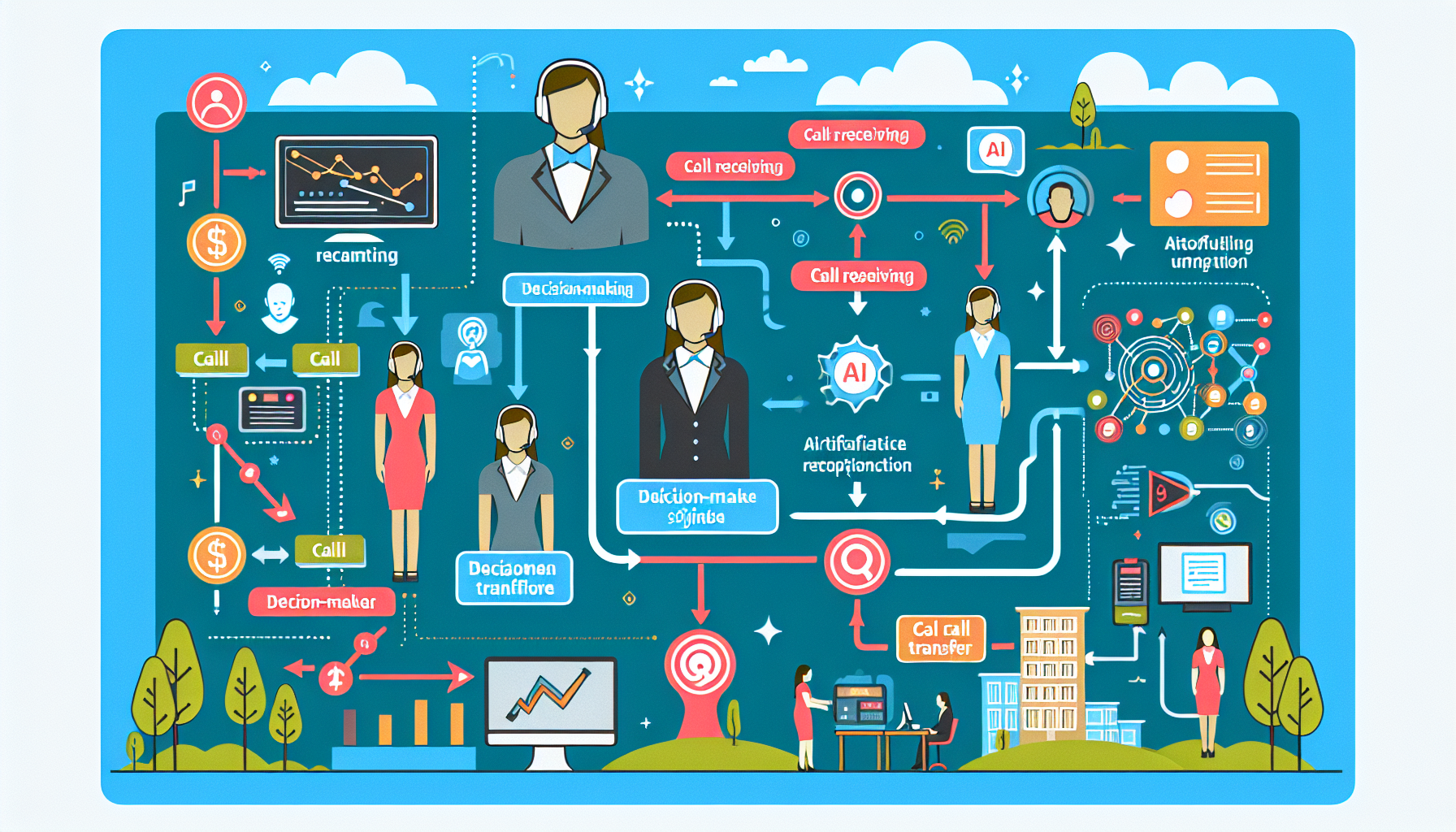
In today's highly digitized and fast-paced world, office reception duties have been notably transformed by the advent of AI Receptionists. These virtual assistants, powered by Artificial Intelligence, are revolutionizing the communication landscape in business environments. Forbes explains how AI is reshaping the core operations of different industries, including reception tasks.

AI Receptionists are programmable, efficient, and deliver round-the-clock service. This ensures the uninterrupted operation of many aspects of business communications. A stand-out benefit is their ability to handle multiple calls simultaneously, making them an ideal solution for high-volume settings. Utilizing cutting-edge technologies like natural language processing and machine learning, these AI-powered systems can understand, learn from, and respond to human speech, thus offering a level of service traditionally associated with human receptionists.
AI Receptionists play a vital role in facilitating seamless transfer of calls. This automated system allows customers to interact and fiercely minimizes the chances of dropped calls as it never gets tired or needs to attend another call, improving customer experience. Entrepreneur discusses how these AI-powered receptionists reduce waiting times and increase customer satisfaction.
Advancements in AI Receptionists provide businesses with increased availability, efficiency, and personalized customer service, setting a new benchmark for telephone communication standards.
Seamless Call Transfers Explained:
In today's hyperconnected era, efficient customer service is key to maintaining customer satisfaction and retaining business. An essential part of this process is the seamless transfer of calls based on the caller's intent. This is where Artificial Intelligence (AI) receptionists are revolutionizing the customer service sphere.
AI receptionists, also known as virtual assistants, leverage advanced technologies, including Natural Language Processing (NLP), to optimize call transfers. These intelligent systems are designed to understand and interpret human language, discern caller intent, and route the caller to the appropriate party or resource without human intervention.
The process begins with the AI receptionist engaging in conversation with the caller. The AI receptionist listens to the caller, uses NLP to analyze and comprehend the customer's needs, and then navigates the internal solutions hierarchy to find the best match. If a customer service representative or department is required, the AI swiftly and accurately transfers the call, thereby facilitating a seamless transfer.
A well-established reality of customer service is the customer's demand for immediate and accurate solutions. Seamless call transfers play a crucial role in meeting these expectations. Interruptions or inaccuracies during transfers can lead to dissatisfaction, impacting customer loyalty and potentially harming the business's reputation. Thus, AI receptionists mitigate these risks by ensuring a smooth, accurate, and prompt transfer process.
In conclusion, AI receptionists, with their ability to facilitate seamless call transfers, provide a pivotal advantage for businesses aiming to bolster their customer service processes. They not only enhance customer satisfaction but also boost operational efficiency by streamlining the call transfer protocol.
```The integration of AI receptionists into enterprise communication systems is a delicate task, colored by various considerations like system compatibility, API functionality, and user experience. Major telecom infrastructures opt for AI receptionists primarily for two reasons - efficiency and round-the-clock availability. Unlike humans, AI doesn't require breaks, ensuring that customers and clients can reach out anytime. More importantly, AI's power of intelligent management makes call transfers seamless, something that human receptionists may struggle with due to volume, speed, or complexity of calls.

Yet, AI receptionists' actual integration is paved with meticulous planning and strategizing. One important factor is the compatibility of AI receptionists with existing systems. This requires thorough system auditing and understanding of potential integration bottlenecks. If an AI receptionist isn't compatible with an organization's system, the receptionist becomes less helpful and may even stall vital communication lines. Therefore, software vendors need to work closely with organizations in confirming compatibility issues before initiating the integration.
Another significant element to consider is the effectiveness of the API or Application Programming Interface. APIs, in essence, allow different software and systems to interact seamlessly, providing a pathway for the AI receptionist to perform its job. For instance, when a customer calls, the API helps the AI receptionist connect with the customer's database, providing important customer data to the representative handling the call. Similarly, when transferring calls, the API comes into play, seamlessly connecting the call to the most qualified representative. Ensuring an efficient API is, therefore, an integral part of a successful AI receptionist integration.
To sum up, the integration of AI receptionists into enterprise-level communication infrastructures plays a huge role in facilitating seamless call transfers. However, such integration goes beyond merely implementing software; it's about establishing a harmonious interplay between human and machine, creating an environment where efficiency meets empathy and where high-speed communication meets human emotions.
With the exponential growth in technology, AI-driven systems like AI Receptionists are increasingly becoming integral to businesses across industries. In various operational realms, these intelligent systems are being tailored to meet the distinct and unique requirements of every business. From managing support calls to handling sales inquiries, or supplying information during general queries - these receptionists can be customized to perform a diversity of functions efficiently.
AI Receptionists can drastically transform how firms manage their customer service. For instance, companies can program these AI-based systems to automatically route incoming calls to the designated personnel or department. If a customer calls querying about a product's features, the AI Receptionist can instantly transfer the call to the sales department. This eliminates the ire of customers being put on hold or transferred multiple times.
Similarly, when addressing support-related calls, AI receptionists can be programmed with all the fundamental troubleshooting steps. This can help speed up the resolution process, subsequently enhancing customer satisfaction. The capacity to resolve common issues without human intervention can also substantially reduce the load on human agents, allowing them to focus more on complex tasks. Furthermore, these AI-based systems can be trained to handle calls out-of-hours, ensuring round-the-clock customer service.
When it comes to general business inquiries or conducting customer surveys, here too, AI Receptionist can be of great utility. They can be trained to deliver succinct yet comprehensive responses to commonly posed questions, easing the information retrieval process for customers. Moreover, AI Receptionists are quite handy for scheduling callbacks based on customer availability, ensuring the follow-up process remains efficient and streamlined.
The role of AI Receptionists in facilitating seamless call transfers cannot be overstated. Its capability to be customized as per varying business needs makes it a versatile and invaluable tool in enhancing customer satisfaction and operational efficiency. What makes these systems even more promising is their capacity to learn and evolve, which means their performance can further improve over time with machine learning and reinforced training.
```AI receptionists have already made significant strides across a diverse range of industries, offering industries an innovative approach to improving call handling efficiency and customer response rates. Below are a couple of notable case studies underscoring the role of AI receptionists in streamlining call transfers.

Case Study 1: E-commerce
An avant-garde e-commerce firm utilized an AI-based virtual assistant to handle its burgeoning call traffic. The AI was programmed to answer customer inquiries, take messages, and efficiently transfer calls to corresponding departments. The results were astounding; the company experienced a 40% increase in call handling, with no observed increase in hold times. Furthermore, customer satisfaction rose by 20%, as rapid responses maximized consumer engagement. Read more about this success story here.
Case Study 2: Healthcare
A healthcare system adopted AI receptionists to manage and direct incoming calls from patients seeking to schedule or reschedule appointments. The AI receptionist was also tasked with answering routine queries, freeing up healthcare personnel to perform more critical tasks. Within a few months of implementing this strategy, the hospital saw a 35% spike in call handling efficiency and an impressive reduction in operational costs. Learn more about their journey here.
These case studies show that AI receptionists are more than capable of increasing call handling efficiency and keeping customer engagement at its peak. They not only excel at swiftly transferring calls but also minimize customer wait times, a definitive advantage in any sector where time is key. With further technological advancements, the potential of AI receptionists in transforming organizational communication is vast.
As the dawn of a new technological age approaches, the role of AI receptionists in facilitating seamless call transfers continues to evolve. Once primarily tasked with routing inbound calls, today's AI receptionists are capable of much more, including intelligent call screening, personalized caller experiences, and CRM integrations. However, future trends and advancements in AI reception technology promise to take these capabilities even further.
One such advancement is the use of machine learning to inform AI receptionist behavior. Current AI systems often rely on predefined scripts and rules, but machine learning allows these systems to adapt and learn over time, improving efficiency and customer interactions. As a result, businesses will be able to provide even more personalized and efficient experiences for callers.
Another significant development is the integration of context-aware systems. These systems use data about the current situation or environment to make decisions. For AI receptionists, this can enable better call routing based on real-time data, such as caller location, time of day, or even the caller's sentiment. This ability could further reduce call waiting times and improve overall customer satisfaction.
Lastly, an exciting area of growth lies in conversational AI. This technology seeks to create more natural, human-like interactions with AI. As it becomes more prevalent, callers will be able to interact with AI receptionists as though they were human, leading to more engaging and satisfying experiences.
Indeed, the future of AI reception technology opens up a world of possibilities. Yet, as these tools continue to evolve and grow smarter, it’s crucial that businesses remain on top of privacy concerns and ensure they’re using this technology ethically and responsibly. But with the benefits they bring – enhanced customer experiences, streamlined operations, and reduced costs – it's clear that AI receptionists will continue to play a pivotal role in the future of business telecommunications.
Start your free trial for My AI Front Desk today, it takes minutes to setup!








